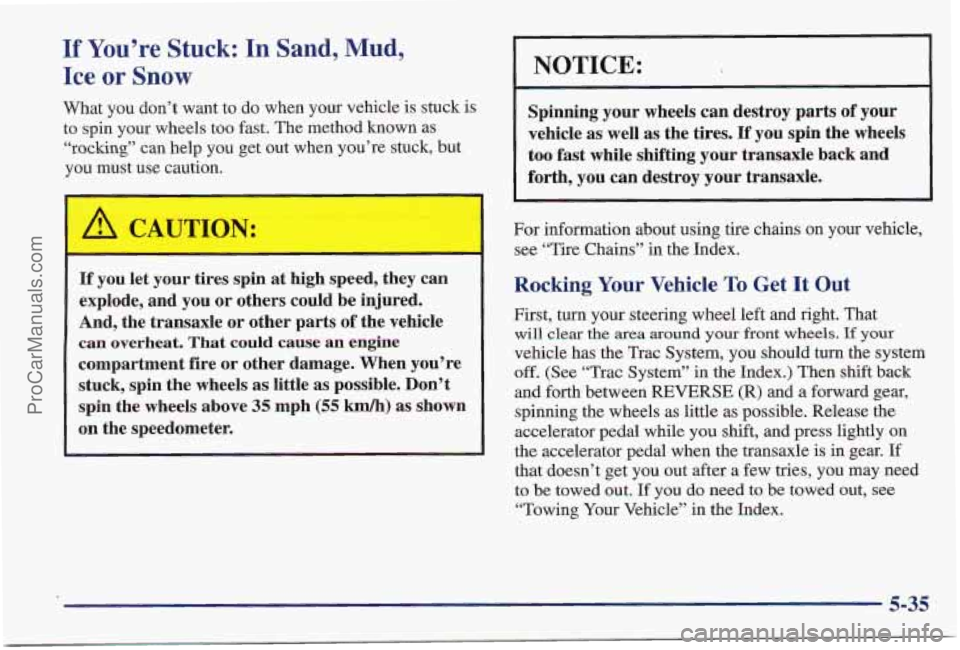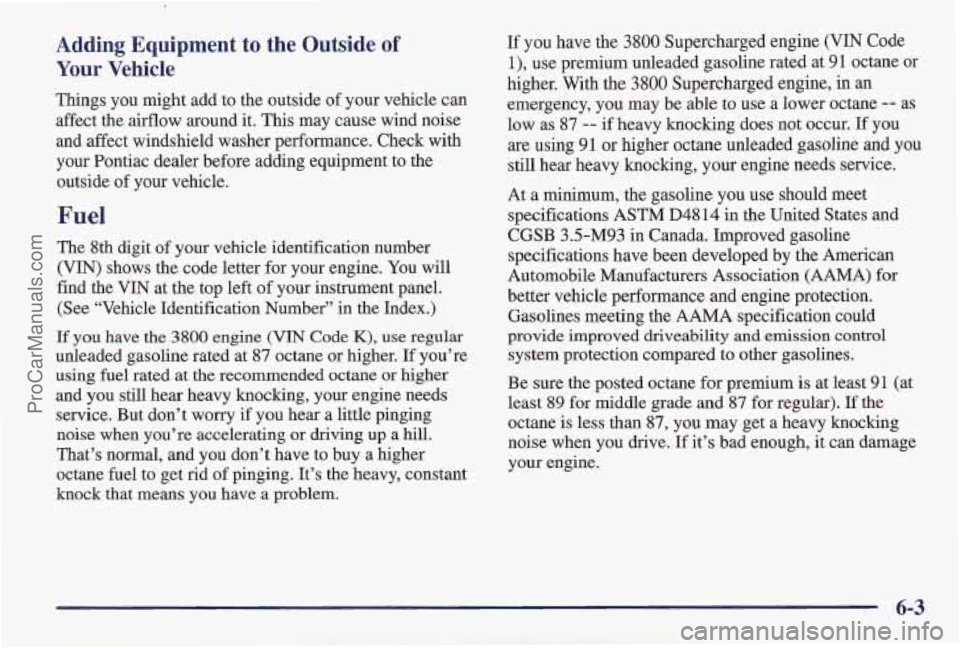Page 269 of 419

If You’re Stuck: In Sand, Mud,
Ice or
Snow
What you don’t want to do when your vehicle is stuck is
to spin your wheels too fast. The method known as
“rocking” can help you get out when you’re stuck, but
you must use caution.
L
If you let your tires spin at high speed, they can
explode, and you or others could be injured.
And, the transaxle or other parts
of the vehicle
can overheat. That could cause an engine
compartment fire or other damage. When you’re
stuck, spin the wheels
as little as possible. Don’t
spin the wheels above
35 mph (55 km/h) as shown
on the speedometer.
NOTICE:
Spinning your wheels can destroy parts of your
vehicle as well as the tires.
If you spin the wheels
too fast while shifting your transaxle back and
forth, you can destroy your transaxle.
For information about using tire chains on your vehicle,
see “Tire Chains” in the Index.
Rocking Your Vehicle To Get It Out
First, turn your steering wheel left and right. That
will clear the area around your front wheels. If your
vehicle has the Trac System, you should turn the system
off. (See “Trac System” in the Index.) Then shift back
and forth between REVERSE (R) and
a forward gear,
spinning the wheels as little as possible. Release the
accelerator pedal while you shift, and press lightly on
the accelerator pedal when the transaxle
is in gear. If
that doesn’t get you out after a few tries, you may need
to be towed
out. If you do need to be towed out, see
“Towing Your Vehicle” in the Index.
ProCarManuals.com
Page 271 of 419

Section 6 Service and Appearance Care
Here you will find information about the care of your Pontiac. This section begins with service and fuel information,
and then it shows how to check important fluid and lubricant levels. There
is also technical information about your
vehicle, and a part devoted to its appearance care.
6-2
6-3 6-5
6-5
6-7
6- 14
6-2 1
6-26
6-32
6-33 6-36
6-37
6-37 6-44
6-46
Doing Your Own Service Work
What Kind of Fuel to Use
Using Fuel in Foreign Countries
Where to Put the Fuel and Filling the Tank
Checking
Things Under the Hood
Checking Your Engine Oil
Automatic Transaxle Fluid
Engine Coolant
Where to Fill the Windshield Washer Fluid
Important Brake Information
Information on Your Vehicle’s Battery
Tips on Vehicle Storage
Bulb Replacement Procedures
Windshield Wiper Blade Replacement
How and When to Check Tire Inflation 6-50
6-52
6-55
6-58
6-59
6-61
6-63
6-64
6-65 6-66
6-66
6-72
6-72
6-73
6-73 When
it is Time to Buy New Tires
Wheel Alignment
Cleaning the Inside of Your Vehicle
Care of the Safety Belts and Built-in
Child Restraint
Cleaning the Outside of Your Vehicle
How to Clean Aluminum Wheels
Underbody Maintenance
Recommended Appearance
Care Materials
Your Vehicle Identification Number (VIN)
The Electrical System
Fuses and Circuit Breakers
Replacement Bulb Types for Your Vehicle
Capacities and Specifications
Air Conditioning Specifications
Normal Replacement Parts
ProCarManuals.com
Page 273 of 419

Adding Equipment to the Outside of
Your Vehicle
Things you might add to the outside of your vehicle can
affect the airflow around it. This may cause wind noise
and affect windshield washer performance. Check with
your Pontiac dealer before adding equipment to the
outside of your vehicle.
Fuel
The 8th digit of your vehicle identification number
(VIN) shows the code letter for your engine. You will
find the VIN at the top left
of your instrument panel.
(See “Vehicle Identification Number” in the Index.)
If you have the 3800 engine (VIN Code K), use regular
unleaded gasoline rated at 87 octane or higher. If you’re
using fuel rated at the recommended octane or higher
and you still hear heavy knocking, your engine needs
service. But don’t worry if you hear a little pinging
noise when you’re accelerating or driving up a hill.
That’s normal, and you don’t have to buy a higher
octane fuel to get rid of pinging. It’s the heavy, constant
knock that means you have
a problem.
If you have the 3800 Supercharged engine (VIN Code
l), use premium unleaded gasoline rated at 91 octane or
higher. With
the 3800 Supercharged engine, in an
emergency, you may be able
to use a lower octane -- as
low as 87
-- if heavy knocking does not occur. If you
are using 91 or higher octane unleaded gasoline and you
still hear heavy knocking, your engine needs service.
At
a minimum, the gasoline you use should meet
specifications ASTM D48
14 in the United States an’d
CGSB 3.5-M93 in Canada. Improved gasoline
specifications have been developed by the American
Automobile Manufacturers Association (AAMA) for
better vehicle performance and engine protection.
Gasolines meeting the AAMA specification could
provide improved driveability
and emission control
system protection compared to other gasolines.
Be sure the posted octane for premium is at least 91 (at
least 89 for middle grade and
87 for regular). If the
octane is less than 87, you may get a heavy knocking
noise when you drive.
If it’s bad enough, it can damage
your engine.
ProCarManuals.com
Page 274 of 419

If your vehicle is certified to meet California Emission
Standards (indicated on the underhood tune-up label),
it
is designed to operate on fuels that meet California
specifications. If such fuels
are not available in states
adopting California emissions standards, your vehicle
will operate satisfactorily on fuels
meeting federal
specifications, but emission control system performance
may be affected. The malfunction indicator lamp
on
your instrument panel may turn on and/or your vehicle
may fail a smog-check test.
If this occurs, return to your
authorized Pontiac dealer for diagnosis to determine
the
cause of failure. In the event it is determined that the
cause of
the condition is the type of fuels used, repairs
may not be covered by your warranty.
Some gasolines that
are not reformulated for low
emissions contain an octane-enhancing additive called
methylcyclopentadlenyl manganese tricarbonyl (MMT); ask your service station operator whether or not his fuel
contains
MMT. General Motors does not recommend the
use of such gasolines. If fuels containing MMT are used,
spark plug life may be reduced and your ernissicrn
control
system performance may be affected. The
malfunction indicator lamp
on your instrument panel
may
turn on. If this occurs, return to your authorized
Pontiac dealer
€or service.
To provide cleaner ais, all gasolines in the United States
are now required to contain additives that will help
prevent deposits
from forming in your engine and fuel
system, allowing your emission control system to
function properly. Therefore,
you should not have to add
anything to the
fuel. In addition, gasolines containing
oxygenates, such as ethers and ethanol, and
reforrnulate'd gasolines may
be available in your area to
help clean the air. General Motors recommends that you
use these gasolines
if they comply with the
specifications described earlier.
~~
NOTICE:
Your vehicle was not designed for fuel that
contains methanol. Don't use it. It
can corrode
metal parts in
your fuel system and also damage
plastic and
rubber parts. That damage wouldn't
be covered under
your warranty.
_____~~
6-4
ProCarManuals.com
Page 277 of 419
When you put the cap back on, turn it to the right
(clockwise) until you hear at least three clicks. Make
sure you fully install the cap.
NOTICE:
If you need a new cap, be sure to get the right
type. Your dealer can get one for you.
If you get
the wrong type, it may not
fit or have proper
venting, and your fuel tank and emissions system
might be damaged.
Checking Things Under the Hood
A CAUTION:
An electric fan under the hood can start up and
injure you even when the engine is not running.
Keep hands, clothing and tools
away from any
underhood electric fan.
Things that burn can get on hot engine parts and
start
a fire. These include liquids like gasoline,
oil, coolant, brake fluid, windshield washer and
other fluids, and plastic
or rubber. You or others
could
be burned. Be careful not to drop or spill
things that will burn onto
a hot engine.
6-7
ProCarManuals.com
Page 279 of 419
When you open the hood of the 3 100 engine, you’ll see:
A. Windshield Washer Fluid
B. Radiator Fill Cap
C. Remote Positive Terminal
D. Power Steering Fluid Reservoir
E. Engine Oil Fill Cap
E Engine Oil Dipstick
G. Automatic Transaxle Dipstick
H. Brake Fluid Reservoir
I. Engine Coolant Reservoir
J. Air Cleaner
6-9
ProCarManuals.com
Page 280 of 419
When you open the hood of the 3800 engine, you’ll see:
A. Windshield Washer Fluid E Engine Oil Fill Cap
€3. Radiator Fill Cap G. Automatic Transaxle Dipstick
C. Remote Positive Battery Terminal H. Brake Fluid Reservoir
D. Power Steering Fluid Reservoir I. Engine Coolant Reservoir
E. Engine Oil Dipstick J. Air Cleaner
6-10
ProCarManuals.com
Page 281 of 419
When you open the hood of the 3800 Supercharged engine, you'll see:
- : I: .,,
A. Windshield Washer Fluid
B. Radiator Fill Cap
C. Remote Positive Battery Terminal
D. Power Steering Fluid Reservoir
E. Engine Oil Dipstick F,
Engine Oil Fill Cap
G. Automatic Transaxle Dipstick
H. Brake Fluid Reservoir
I. Engine Coolant Reservoir
J. Air Cleaner
6-11
ProCarManuals.com